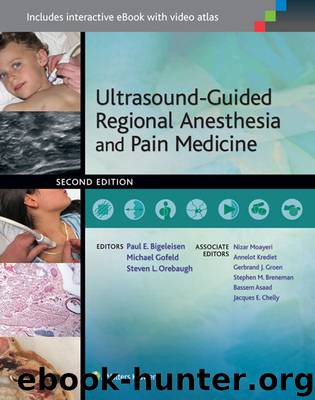Ultrasound-Guided Regional Anesthesia and Pain Medicine by Bigeleisen Paul E. & Gofeld Michael & Orebaugh Steven L

Author:Bigeleisen, Paul E. & Gofeld, Michael & Orebaugh, Steven L.
Language: eng
Format: epub
ISBN: 9781451173338
Publisher: LWW
Published: 2015-03-09T04:00:00+00:00
In this chapter, anatomical aspects relevant for ultrasonography of the TPV space are highlighted. Correlations between high-frequency ultrasound scans with high-resolution digitized anatomy are discussed in depth. This enables practitioners of regional anesthesia to appraise the spatial orientation of landmarks for TPV blockade on cross-sectional images that correspond to ultrasound images in clinical practice.
The anatomical images were obtained by slicing blocks of tissue from a human cadaver in transversal sections (interval: 78 µm) using a heavy-duty sledge cryomicrotome. The surface of each section was photographed at high resolution. Thousands of digitized photographs were thus obtained and then digitally stacked on top of each other using self-developed software to reconstruct the three orthogonal planes (sagittal, coronal, and transversal). The technique is described in detail elsewhere.11
Review of thoracic paravertebral (TPV) space anatomy
The TPV space is wedge-shaped.12 Figure 36.1 shows the TPV space in transverse, sagittal, and coronal cross sections at the level of T7. The base of the wedge is formed by the vertebral body, the intervertebral disk, and the intervertebral foramen medially. Laterally, the space tapers and proceeds as the intercostal space. The anterior boundary is formed by the parietal pleura (T2–T9/T10), the diaphragm (T9/T10–T12), and the mediastinum. Posteriorly, the transverse process, the superior costotransverse ligament (SCTL), and the paraspinal musculature confine the TPV space. The SCTL runs from the superior crest of the neck of the rib toward the anterior-inferior surface of the transverse process superior to it. The TPV space is filled with adipose and loose connective tissue and furthermore contains the spinal nerve, the sympathetic trunk, and the intercostal vessels. It communicates with the epidural space medially, the intercostal space laterally, adjacent TPV spaces cranially and caudally, the prevertebral space anteriorly, and with adipose tissue posterior to the SCTL (Figs. 36.2 to 36.7).
Download
This site does not store any files on its server. We only index and link to content provided by other sites. Please contact the content providers to delete copyright contents if any and email us, we'll remove relevant links or contents immediately.
| Administration & Medicine Economics | Allied Health Professions |
| Basic Sciences | Dentistry |
| History | Medical Informatics |
| Medicine | Nursing |
| Pharmacology | Psychology |
| Research | Veterinary Medicine |
Periodization Training for Sports by Tudor Bompa(7925)
Why We Sleep: Unlocking the Power of Sleep and Dreams by Matthew Walker(6362)
Paper Towns by Green John(4800)
The Immortal Life of Henrietta Lacks by Rebecca Skloot(4260)
The Sports Rules Book by Human Kinetics(4079)
Dynamic Alignment Through Imagery by Eric Franklin(3921)
ACSM's Complete Guide to Fitness & Health by ACSM(3826)
Kaplan MCAT Organic Chemistry Review: Created for MCAT 2015 (Kaplan Test Prep) by Kaplan(3802)
Introduction to Kinesiology by Shirl J. Hoffman(3627)
Livewired by David Eagleman(3535)
The River of Consciousness by Oliver Sacks(3420)
The Death of the Heart by Elizabeth Bowen(3342)
Alchemy and Alchemists by C. J. S. Thompson(3297)
Descartes' Error by Antonio Damasio(3167)
Bad Pharma by Ben Goldacre(3100)
The Emperor of All Maladies: A Biography of Cancer by Siddhartha Mukherjee(2931)
The Gene: An Intimate History by Siddhartha Mukherjee(2928)
The Fate of Rome: Climate, Disease, and the End of an Empire (The Princeton History of the Ancient World) by Kyle Harper(2875)
Kaplan MCAT Behavioral Sciences Review: Created for MCAT 2015 (Kaplan Test Prep) by Kaplan(2816)
